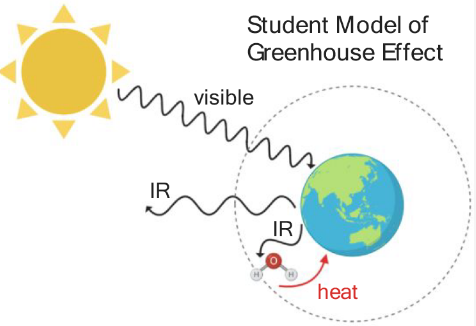Physical Chemistry in Context: Using Quantum Mechanics to Understand the Greenhouse Effect

The concepts taught in an undergraduate physical chemistry course are directly related to the molecular processes governing climate change, yet the connections between quantum mechanical molecular properties and global warming are rarely made explicit. To improve student knowledge about climate change, we developed a three-part activity that computationally and experimentally explores blackbody radiation, the greenhouse effect, and the relationship between IR absorption properties and global warming potentials for the anthropogenic greenhouse gases defined in the Paris Agreement. The activities addressed the traditional learning objectives of a quantum-focused physical chemistry course by exploring topics such as the quantized nature of energy in Planck’s Law, the selection rules for rovibrational transitions, and discrepancies between theoretical models and observed experimental results. However, our approach was unique in that each concept was addressed within the context of the atmospheric phenomena related to climate change. A previously published climate science survey instrument was administered pre- and postactivity to assess student learning gains. The average percent of correct responses on this survey increased from 44% to 68% as a result of completing the activities.
The activities focused on (1) blackbody radiation and the greenhouse effect, (2) collection and interpretation of the IR spectrum of carbon dioxide, and (3) calculation of the GWPs of several anthropogenic greenhouse gases based on IR vibrational intensities generated from density functional theory (DFT) calculations.
Learning Objectives
- Describe, both qualitatively using pictorial representations and quantitatively using Planck’s Law, how the radiative properties of the sun and the Earth and the infrared absorption of atmospheric gases lead to the greenhouse effect.
- Explain how molecular properties and IR selection rules determine the IR absorption intensity of a vibrational mode and relate this to measured or calculated IR absorption spectra.
- Explain discrepancies between the harmonic oscillator and Morse potential energies and eigenstates, and why these differences necessitate the application of frequency correction factors to vibrational spectra generated using quantum mechanical calculations.
- Calculate the global warming potential of a gas using an IR spectrum and explain how factors such as radiative forcing, density, and atmospheric lifetime influence the GWP.
- Use a Jablonski diagram to explain molecular excitation and relaxation processes and describe the role those molecular processes play in planetary energy balance.
Citation
W. Paige Hall and Lily Gunning, Journal of Chemical Education, 2023, 100(3), 1333-1342, doi.org/10.1021/acs.jchemed.2c00550